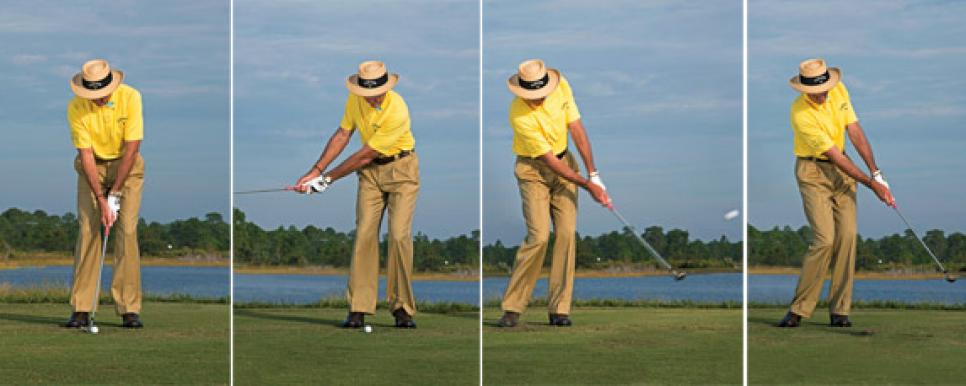Short Game
Wristless, Riskless Short Game
Many tour pros use a little wrist action in their short-game swings. They can do this because of their talent level, along with the thousands of hours of practice they put in. For amateurs who don't have a lot of time to work on their games, wrist action adds difficulty and risks inconsistency on greenside shots. Besides, you don't need it. Steve Stricker, a wonderful short-game player, hits a variety of shots around the greens with barely any wrist action. I'm going to show you six shots that minimize the role of the wrists and, as a result, reduce the odds of mistakes. Copy these techniques, and you'll be able to save more strokes with your wedges without spending lots of time at the practice green.
1. BASIC PITCH

WHEN TO USE: You have a decent lie and some green to work with, but there's an obstacle to carry, like a bunker.
HOW TO EXECUTE: Set up in a narrow, slightly open stance, with the clubface square. Keeping your hands and arms relaxed, swing back by rotating your upper body away from the target. Your wrists should stay passive but not rigid. Almost pause at the end of the backswing, then turn through until your chest faces the target.
2. SAND SHOT

WHEN TO USE: You have a good lie in a relatively flat area in a greenside bunker.
HOW TO EXECUTE: Play the ball off your front foot, and open your stance and clubface slightly. Set more weight on your front leg. Start back by turning your shoulders and chest, swinging the club along your open stance. Don't cock your wrists. Swing down into the sand behind the ball, rotating your chest as you follow through. Keep your knees flexed throughout.
3. LOW RUNNER

WHEN TO USE: You are near the green and have room to run the ball up to the hole.
HOW TO EXECUTE: Take a narrow stance, address the ball just back of center, and set your elbows in close to your sides. Again, the shoulders turn to create the backswing, and the chest rotates forward to move the club through the ball. Keep the swing compact. Here's a good cue to avoid wrist action: Maintain the triangle formed by your arms and chest all the way to the finish.
4. CHECKING PITCH

WHEN TO USE: Your lie is good, but you have to carry an obstacle and stop the ball quickly on the green.
HOW TO EXECUTE: Play the ball back in your stance, and open the clubface slightly. Swing back slowly, with your wrists staying firm, then make an aggressive turn through the shot, stopping a few feet past impact. It's a crisp action, like striking a match. The ball grabs after a couple of bounces.
5. ROUGH PITCH (BELOW)
WHEN TO USE: Your ball is sitting down, making it impossible to hit it cleanly.
HOW TO EXECUTE: Take a wide stance, and play the ball just forward of center. Open the face, and shift most of your weight to your front foot. The key to this shot is holding the face open as you make a firm downswing and cut off the finish. To slide the club under the ball, it's important to keep your knees flexed and resist the urge to try to help the ball up.

6. FLOP SHOT

WHEN TO USE: You have some cushion under the ball and an obstacle to carry, and you need to stop it quickly.
HOW TO EXECUTE: Stand wider than normal, and play the ball off your front heel. Open your stance and the clubface. From there, make a smooth swing back and through, extending your arms wide. The club should swing along your stance line, or out to in through impact. Feel as if the back of the clubhead skims along the turf.